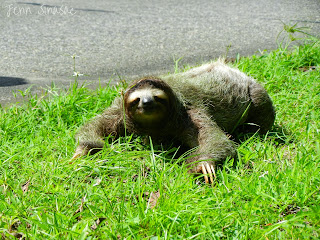It's been a busy month! During my little hiatus from posting to my blog (and believe me, I have a lot to catch up on), I have had a great visit from my Dad (his first time in Panama), moved houses, and picked up the pace at work.. including spending much more time in the field! Which means, more natural encounters! I have so much to say, had a lot of great sightings in the last month, but I'll start with this one.
 |
| Three-toed Sloth crossing the road |
Yesterday we were on our way back to the Canopy Tower from Gamboa after a morning of birding along Pipeline Road, and saw a Brown-throated Three-toed Sloth crossing the highway. We pulled over to get a closer look and help her across the road. Traffic flies down this highway, and unfortunately a lot of animals—from snakes to anteaters to vultures, and everything in between—get hit regularly.
As we took a closer look at her, we could see a small arm wrapped around her side—this mama had a baby holding on tight to her chest! We slowed traffic to ensure they made it to the other side, and to make sure she didn't try crossing back again, Alexis picked her up and placed her and her baby on the trunk of a tree.
 |
| Mama and baby Three-toed Sloth |
 |
| Mama sloth on tree |
Brown-throated Three-toed Sloths are one of six species of sloths, classified into two families, Megalonychidae (two-toed sloths) and Bradypodidae (three-toed sloths). They are slow-moving, arboreal mammals; they spend almost all their time in the treetops. They come down to the ground only once a week, to go to the bathroom! Sloths have long, coarse fur, which is often home to a variety of other organisms, including moths, beetles and fungi. They often appear greenish, due to the presence of algae in their fur. They eat leaves, shoots and buds, and are particularly fond of Cecropia trees, making them easy to spot. Due to their folivorous diet, they receive very little energy from their food, and have lower metabolic rates and body temperatures than other mammals. They are generally very slow moving, and spend a lot of time sleeping. In fact, the Spanish name for sloth is "perezoso", meaning lazy! In central Panama, two species of sloth—Brown-throated Three-toed Sloth and Hoffmann's Two-toed Sloth—are common, and once you get your sloth-spotting eyes attuned, you may see them on a regular basis in Soberania National Park and other forested areas. They are truly a unique animal.
~ Jenn